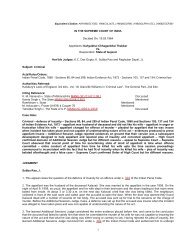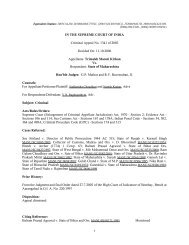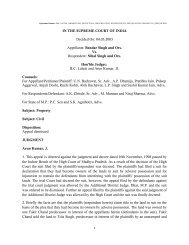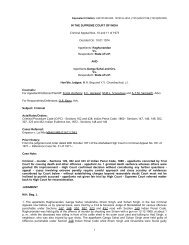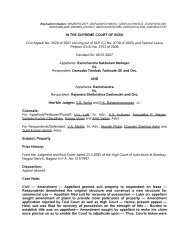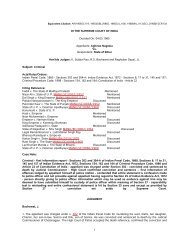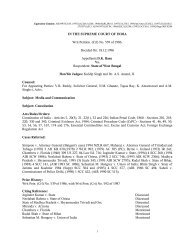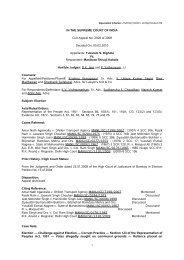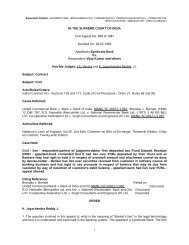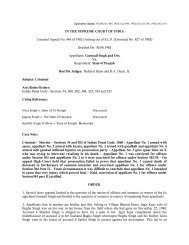Chandramohan Ramchandra Patil and
Chandramohan Ramchandra Patil and
Chandramohan Ramchandra Patil and
Create successful ePaper yourself
Turn your PDF publications into a flip-book with our unique Google optimized e-Paper software.
Equivalent Citation: AIR2003SC1754, 2003(2)ALLMR(SC)1126, 2003(1)CTC621, JT2003(2)SC226, (2003)2MLJ118(SC),<br />
2003(2)SCALE352, (2003)3SCC552, [2003]2SCR203<br />
IN THE SUPREME COURT OF INDIA<br />
Civil Appeal No. 9393 of 1995<br />
Decided On: 19.02.2003<br />
Appellants: <strong>Ch<strong>and</strong>ramohan</strong> <strong>Ramch<strong>and</strong>ra</strong> <strong>Patil</strong> <strong>and</strong> Ors.<br />
Vs.<br />
Respondent: Bapu Koyappa <strong>Patil</strong> (Dead) through Lrs. <strong>and</strong> Ors.<br />
Hon'ble Judges: Brijesh Kumar <strong>and</strong> D.M. Dharmadhikari, JJ.<br />
Counsels:<br />
For Appellant/Petitioner/Plaintiff: R. Sundaravardhan, Sr. Adv., Shivaji M. Jadhav <strong>and</strong> Himanshu<br />
Gupta, Advs<br />
For Respondents/Defendant: Sanjay K. Visen <strong>and</strong> A.S. Bhasme, Advs., V.D. Khanna, Adv.(NP) <strong>and</strong><br />
Manjula Gupta, Adv.<br />
Subject: Property<br />
Subject: Civil<br />
Acts/Rules/Orders:<br />
Bombay Pargana <strong>and</strong> Kulkarni Watans Abolition Act, 1950; Bombay Inferior Village Watans Abolition Act,<br />
1958; Evidence Act - Sections 30(5) <strong>and</strong> 50; Civil Procedure Code (CPC) - Section 100 - Order 41, Rules<br />
4 <strong>and</strong> 33<br />
Cases Referred:<br />
Kalgonda Babgonda <strong>Patil</strong> v. Balgonda Kalgonda <strong>Patil</strong> etc. etc., MANU/SC/0255/1989; Annasaheb<br />
Bapusaheb <strong>Patil</strong> v. Balwant, MANU/SC/0172/1995; Laxmibai Sadashiv Date v. Ganesh Shankar<br />
DateMANU/MH/0043/1977; Dhondi Vithoba Koli v. Mahadeo Dagdu KoliMANU/MH/0093/1973;<br />
Santosh Hazari v. Purushottam Tiwari (deceased) Thr. LRs., MANU/SC/0091/2001; Ratanlal v. Firm<br />
Lalman Das, (MANU/SC/0021/1969; Jiwan Nath v. State of M.P. MANU/SC/0572/1971<br />
Prior History:<br />
From the Judgment <strong>and</strong> Order dated 12.1.90 of the Bombay High Court in A. No. 564 of 1978<br />
Disposition:<br />
Appeal dismissed<br />
Citing Reference:<br />
Kalgonda Babgonda <strong>Patil</strong> v. Balgonda Kalgonda <strong>Patil</strong> etc. etc. MANU/SC/0255/1989<br />
Mentioned<br />
Annasaheb Bapusaheb <strong>Patil</strong> v. Balwant MANU/SC/0172/1995<br />
Relied on<br />
Santosh Hazari v. Purushottam Tiwari (deceased) Thr. LRs. MANU/SC/0091/2001<br />
Relied on<br />
Ratanlal v. Firm Lalman Das Relied on<br />
Jiwan Nath v. State of M.P. Relied on
Case Note:<br />
Evidence Act,1872- Section 30 (5) <strong>and</strong>50 – Bombay pargaana & Kulkarni watans abolition act, 1950<br />
– Bombay Inferior village watans abolition Act,1958 – Civil procedure code,1908 – Section 100,<br />
Order 41, Rules 4 <strong>and</strong> 33 – Plaintiff filing suit for partition of watan or Inam l<strong>and</strong> – Trial Court<br />
dismissing suit while first appellate court <strong>and</strong> High Court decreeing the suit – Defendants<br />
assailing decree on the ground of correctness of establishing of relationship between plaintiff <strong>and</strong><br />
first wat<strong>and</strong>ar <strong>and</strong> on ground of adverse inference – Evidence of pedigree given by plaintiff held<br />
admissible to prove relationship – No evidence to prove adverse inference of defendants – There<br />
being substantial compliance of 5.100 of code of civil procedure, prayer for rem<strong>and</strong> absolutely<br />
without merit – As appellate court could grant relief to non-appealing plaintiffs, defendants plea<br />
that dismissal of suit became final between non-appealing plaintiffs & defendants unsustainable –<br />
Appeal dismissed.<br />
Dharmadhikari, J.<br />
JUDGMENT<br />
1. The present appellants were defendants before the Trial Court in suit for partition instituted in the Court<br />
of Civil Judge, Jr. Division, Kagal, District Kolhapur in the State of Maharashtra. The suit filed by the<br />
deceased plaintiff [now represented by his legal representatives impleaded as respondents herein] for<br />
partition of the erstwhile Watan or Inam l<strong>and</strong>s of his family was dismissed by the trial Court. The First<br />
Appellate Court by judgment of reversal decreed the suit of the plaintiff <strong>and</strong> it has been confirmed by the<br />
High Court in second appeal recognising the plaintiff's right of partition of the suit l<strong>and</strong>s to the extent of<br />
1/3 share. The preliminary decree has been framed for passing a final decree <strong>and</strong> grant of separate<br />
possession.<br />
2. Learned counsel appearing for the defendants, assails the decree of partition granted to the<br />
plaintiff/respondent but does not dispute the legal position settled by the two Judges Bench decision of<br />
this Court in the case of Kalgonda Babgonda <strong>Patil</strong> v. Balgonda Kalgonda <strong>Patil</strong> etc. etc.<br />
MANU/SC/0255/1989 : AIR1989SC1042a <strong>and</strong> three Judges Bench decision of this Court in the case<br />
of Annasaheb Bapusaheb <strong>Patil</strong> v. Balwant MANU/SC/0172/1995 : [1995]1SCR88 . In the aforesaid<br />
two Judges <strong>and</strong> three Judges Bench decisions of this Court, it has been held that erstwhile Inam or<br />
Watan l<strong>and</strong>s held by the senior most member of the family through, lineal descendant on the rule of<br />
primogeniture, on abolition of Im<strong>and</strong>ari or Wat<strong>and</strong>ari under the provisions of Bombay Pargana <strong>and</strong><br />
Kulkarni Watans Abolition Act (60 of 1950) <strong>and</strong> thereafter by the Bombay Inferior Village Watans Abolition<br />
Act, 1958, after re-grant of those categories of l<strong>and</strong> to the Wat<strong>and</strong>ar or Inamdar, become partible<br />
properties between the members of the family of the Wat<strong>and</strong>ar or Inamdar. See the following statement of<br />
law in the decision of three Judges Bench in the case of Annasaheb Bapusaheb <strong>Patil</strong> (Supra):-<br />
"The lineal primogeniture regulating succession to the estate cannot prevail under Section 4 of 1955 Act,<br />
as being nothing more than incidents of the watan which st<strong>and</strong> abrogated by Section 4 of the Act. It was,<br />
therefore, held that watan families if had a hereditary interest in the watan property, such inheritance<br />
enures to the benefit of all the members of the family as the property belongs to the family <strong>and</strong> all persons<br />
belonging to the watan family who had a hereditary interest in such watan property were entitled to be<br />
called "wat<strong>and</strong>ars of the same watan" within the Watan Act. The members of the joint Hindu family must<br />
be regarded as holders of the watan lang along with the wat<strong>and</strong>ar for the time being <strong>and</strong> therefore, the regrant<br />
of the l<strong>and</strong>s to the wat<strong>and</strong>ar under Section 4 of that Act must enure to the benefit of the entire joint<br />
Hindu family. This Court upheld the full Bench judgment of the Bombay High Court reported in Laxmibai<br />
Sadashiv Date v. Ganesh Shankar DateMANU/MH/0043/1977 : AIR1977Bom350 <strong>and</strong> Anr. judgment<br />
in Dhondi Vithoba Koli v. Mahadeo Dagdu Koli MANU/MH/0093/1973 : AIR1973Bom323 . The<br />
Division Bench judgment in Babgonda case was overruled".
3. The first ground urged by the learned counsel for the defendants is that the original deceased plaintiff<br />
Bapu Koyappa <strong>Patil</strong> failed to prove his relationship with the main ancestor Suryaji, who was the first<br />
Wat<strong>and</strong>ar, hence his claim for partition to the extent of 1/3 share was rightly negatived by the trial court.<br />
4. The question of relationship <strong>and</strong> the dispute on the correctness of the pedigrees produced by the<br />
parties in the case for proof of relationship of the parties with the original ancestor Suryaji, is essentially a<br />
question of fact. The trial court in non-suiting the plaintiff has recorded a finding amongst others that in the<br />
pedigree Ex. 71 the branch of sons of Suryaji, to which the plaintiff claims to be belonging, is not shown<br />
<strong>and</strong> that was produced in proceedings in the year 1945. The First Appellate Court went thoroughly into<br />
the dispute of correctness of the rival pedigrees filed by the parties <strong>and</strong> chose to rely on the oldest<br />
pedigree Ex.69 which explains relationship of the members of the family of Suryaji on 05.1.1874. In that<br />
pedigree all the branches of sons of Suryaji including the plaintiff's branch was shown. There were, thus,<br />
three pedigrees of different periods Ex. 67, 69 <strong>and</strong> 71 before the court <strong>and</strong> court came to the conclusion<br />
that Ex.71 which is the pedigree produced by the plaintiff has to be accepted as genuine as it gets<br />
support from the earliest pedigree of the years 1870 <strong>and</strong> 1874.<br />
5. The above discussion of evidence have been duly taken note of by the High Court in second appeal<br />
<strong>and</strong> the decision of the appellate court on that issue has been upheld. For the aforesaid reasons, it is not<br />
open to the defendants to raise ground on the correctness of the finding of fact on the issue of<br />
relationship. The evidence of pedigree relied by the first appellate court <strong>and</strong> the High Court is relevant<br />
<strong>and</strong> admissible to prove relationship under Section 30(5) <strong>and</strong> Section 50 of the Evidence Act.<br />
6. Learned counsel appearing for the appellants then urged that the courts below ought to have dismissed<br />
the suit for partition on the ground that it was barred by limitation as the predecessors-in-title of the<br />
defendants had prescribed his adverse possession on the l<strong>and</strong>. In support of this argument, it is<br />
submitted that the most important document was ignored by the courts below being order of the then<br />
Regency Court of Kolhapur Estate dated 30 th March, 1945 [Ex.68]. The order of the Regency Court of the<br />
erstwhile Estate of Kolhapur was passed in appeal in revenue proceedings in which predecessors-in-title<br />
of the plaintiff objected to the claim of predecessors-in-title of the defendants to the status of Wat<strong>and</strong>ar.<br />
The claim of the predecessors-in-title of the defendants to the status of Wat<strong>and</strong>ar was on the basis of his<br />
adoption by Hari who was one of the sons of the original Wat<strong>and</strong>ar Suryaji.<br />
7. It is argued that by order dated 30 th March, 1945 of the Regency Court, the objection of the<br />
predecessors-in-title of the plaintiff was rejected <strong>and</strong> the predecessors-in-title of the defendants was<br />
recognised as Wat<strong>and</strong>ar. The erstwhile Wat<strong>and</strong>ar, thus, came in possession of the suit l<strong>and</strong>s <strong>and</strong> there<br />
was thus, a clean ouster from the l<strong>and</strong>s of the plaintiff's predecessors-in-title. It is submitted that the<br />
possession of the predecessors-in-title of the defendants from the year 1945 was, thus, adverse <strong>and</strong> had<br />
ripened into title by prescription. The trial court, therefore, was right in dismissing the suit for partition on<br />
the ground of defendants having prescribed adverse possession.<br />
8. We find that there is a serious flaw in the legal argument claiming title by adverse possession. The suit<br />
l<strong>and</strong>s held by erstwhile Wat<strong>and</strong>ar of Inamdar were impartible under the then existing law. The contest<br />
inter se for the status of Wat<strong>and</strong>ar between members of the family ended by order of ?Regency Court<br />
dated 30 th March, 1945 <strong>and</strong> the only result was that the predecessors-in-title of the defendants was<br />
allowed to possess the l<strong>and</strong> as Wat<strong>and</strong>ar being the eldest member of the family of original Wat<strong>and</strong>ar on<br />
the rule primogeniture. After the abolition of Watan or Inam <strong>and</strong> when a re-grant of the l<strong>and</strong> was made to<br />
the Wat<strong>and</strong>ar, the properties came back to the whole body of joint family of the erstwhile Wat<strong>and</strong>ar <strong>and</strong><br />
he then possessed the l<strong>and</strong> for <strong>and</strong> on behalf of the family. Such l<strong>and</strong>s which were re-granted to<br />
Wat<strong>and</strong>ar became properties returned to the family of the Wat<strong>and</strong>ar <strong>and</strong> became partible. The<br />
possession of the predecessors-in-title of the defendants pursuant to the order of Regency Court on 30 th<br />
March, 1945 as Wat<strong>and</strong>ar cannot be held to be adverse to the other members of the family after the<br />
abolition of Inams <strong>and</strong> Watans <strong>and</strong> regrant of those l<strong>and</strong>s to the Wat<strong>and</strong>ar. The Inam <strong>and</strong> Watan l<strong>and</strong>s<br />
thus regranted to the Wat<strong>and</strong>ar enured for the benefit of whole family of Wat<strong>and</strong>ar <strong>and</strong> it is only thereafter<br />
they became partible. Two courts below have not found any evidence on record to infer adverse<br />
possession of the defendants after the l<strong>and</strong>s were returned to the family of Wat<strong>and</strong>ar on abolition of<br />
Inams <strong>and</strong> Watans. The right to partition was denied only when the plaintiff dem<strong>and</strong>ed partition by a
notice. The suit thereafter was filed within the prescribed period of limitation. Similar argument based on<br />
adverse possession <strong>and</strong> limitation has been repelled by three Judges Bench of this Court in the case of<br />
Annasaheb Bapusaheb <strong>Patil</strong> (Supra) <strong>and</strong> the following legal position explained therein fully answers the<br />
plea against the defendants:-<br />
"The possession of the family property by a member of the family cannot be adverse to the other<br />
members but must be held to be on behalf of himself <strong>and</strong> other members. The possession of one,<br />
therefore, is the possession of all. The burden lies heavily on the member setting up adverse possession<br />
to prove adverse character of his possession by establishing affirmatively that to the knowledge of other<br />
member he asserted his exclusive title <strong>and</strong> the other members were completely excluded from enjoying<br />
the property <strong>and</strong> that such adverse possession had continued for the statutory period. Mutation in the<br />
name of the elder brother of the family for the collection of the rent <strong>and</strong> revenue does not prove hostile act<br />
against the other. The right of the plaintiff to file suit for partition had arisen after the Act has come into<br />
force <strong>and</strong> re-grant was made by the Collector under Sub-section (1) of Section 5. The defendant,<br />
therefore, must plead <strong>and</strong> prove that after the re-grant, he asserted his own exclusive right, title <strong>and</strong><br />
interest to the plaint schedule property to the knowledge of the plaintiff <strong>and</strong> the latter acquiesced to such a<br />
hostile exercise of the right <strong>and</strong> allowed the defendant to remain in continuous possession <strong>and</strong> enjoyment<br />
of the property in assertion of that hostile title during the entire statutory period of 12 years without any let<br />
<strong>and</strong> hindrance <strong>and</strong> the plaintiff stood thereby.<br />
9. The learned counsel then urged some technical grounds. It is argued that since the High Court did not<br />
frame substantial questions of law as required by Section 100 of Code of Civil Procedure, the case<br />
should be rem<strong>and</strong>ed for fresh decision as is being done by this Court after interpretation of Section 100<br />
of Code of Civil Procedure in the case of Santosh Hazari v. Purushottam Tiwari (deceased) Thr.<br />
LRs. [2001 (3) SCC 179] MANU/SC/0091/2001 : [2001]251ITR84(SC) .<br />
10. From the judgment under appeal, we find that the High Court in its body of judgment has clearly<br />
formulated for answer two questions thus:-<br />
"Firstly, whether the plaintiff respondent has established his relationship (as given in the pedigree) <strong>and</strong><br />
secondly whether the plaintiff is entitled to claim partition?"<br />
11. In our opinion, these two questions have been lucidly answered by the High Court by considering the<br />
arguments advanced before it on relationship <strong>and</strong> adverse possession. We, therefore, find that there is<br />
more than substantial compliance of the provisions of Section 100 of Code of Civil Procedure <strong>and</strong> a<br />
prayer for rem<strong>and</strong> is absolutely without any merit. The suit of the year 1977 under the second appeal in<br />
the High Court was decided in the year 1990. We have given full hearing to the parties on all questions of<br />
law raised or which would be raised before the High Court. A prayer for rem<strong>and</strong> of the case in such<br />
circumstances for fresh decision of second appeal is wholly uncalled for.<br />
12. Lastly, it is urged that not all the legal representatives of the original plaintiff had preferred appeal<br />
against the dismissal of suit by the trial court. In accordance wit Order 41 of Rule 4 of Code of Civil<br />
Procedure, the appellate court could not have varied the judgment of the trial court against the defendants<br />
at the instance of only some of the plaintiffs appealing against the decree.<br />
13. This argument has no merit. in a suit for partition, plaintiff <strong>and</strong> defendants are parties of equal status.<br />
If the right of partition has been recognised <strong>and</strong> upheld by the court, merely because only some of the<br />
plaintiffs had appealed <strong>and</strong> not all, the court was not powerless. It could invoke provisions of Order 41 of<br />
Rule 4 read with Order 41 of Rule 33 of Code of Civil Procedure. The object of Order 41 of Rule 4 is to<br />
enable one of the parties to a suit to obtain relief in appeal when the decree appealed from proceeds on a<br />
ground common to him <strong>and</strong> others. The court in such an appeal may reverse or vary the decree in favour<br />
of all the parties who are in the same interest as the appellant. [See Ratanlal v. Firm Lalman Das<br />
MANU/SC/0021/1969 : [1970]1SCR296 ; <strong>and</strong> Jiwan Nath v. State of M.P. MANU/SC/0572/1971<br />
: AIR1971SC744 ].
14. Order 41 Rule 4 of the Code enables reversal of the decree by the court in appeal at the instance of<br />
one or some of the plaintiffs appealing <strong>and</strong> it can do so in favour of even non-appealing plaintiffs. As a<br />
necessary consequence such reversal of the decree can be against the interest of the defendants vis-avis<br />
non-appealing plaintiffs. Order 41 Rule 4 has to be read with Order 41 Rule 33. Order 41 Rule 33<br />
empowers the appellate court to do complete justice between the parties by passing such order or decree<br />
which ought to have been passed or made although not all the parties affected by the decree had<br />
appealed.<br />
15. In our opinion, therefore, the appellate court by invoking Order 41 Rule 4 read with Order 41 Rule 33<br />
of the Code Could grant relief even to the non-appealing plaintiffs <strong>and</strong> make an adverse order against all<br />
the defendants <strong>and</strong> in favour of all the plaintiffs. In such a situation, it is not open to urge on behalf of the<br />
defendants that the decree of dismissal of suit passed by the trial court had become final inter se between<br />
the non-appealing plaintiffs <strong>and</strong> the defendants.<br />
16. Consequent upon the aforesaid discussion, this appeal fails <strong>and</strong> is hereby dismissed with costs.<br />
17. Counsel's fee be allowed as per rules.



